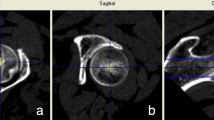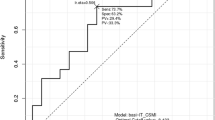Abstract
Purpose
Subsequent contralateral fragility hip fracture (SCHF) is one of the most serious conditions in osteoporotic patients due to high morbidity and mortality. This study aimed to investigate the predictive ability of radiographic morphologic parameters for SCHF in patients diagnosed with unilateral fragility hip fractures.
Methods
We conducted a retrospective observational study of unilateral fragility hip fracture patients between April 2016 and December 2021. Radiographic morphologic parameters, including canal-calcar ratio (CCR), cortical thickness index (CTI), canal-flare index (CFI), and morphological cortical index (MCI), were measured from patients’ contralateral proximal femur anteroposterior radiographic study to evaluate the risk of SCHF. Multivariable logistic regression analysis was employed to determine the adjusted predictive ability of the radiographic morphologic parameters.
Results
Of the included 459 patients, 49 (10.7%) experienced SCHF. All radiographic morphologic parameters demonstrated excellent performance in predicting SCHF. After being adjusted by patients’ age, BMI, visual impairment status, and dementia, CTI revealed the greatest adjusted odds ratio for SCHF of 35.05 (95% CI 7.34 to 167.39, p < 0.001) followed by CFI (OR = 13.32; 95% CI 6.50 to 27.32, p < 0.001), MCI (OR = 5.60; 95% CI 2.84 to 11.04, p < 0.001), and CCR (OR = 4.50; 95% CI 2.32 to 8.72, p < 0.001).
Conclusion
CTI demonstrated the greatest odds ratio for SCHF, followed by CFI, MCI, and CCR. These radiographic morphologic parameters could provide a preliminary prediction for SCHF in elderly patients presenting with unilateral fragility hip fractures.


Similar content being viewed by others
Data availability
The data that support the findings of this study are available from the corresponding author, N. A., upon reasonable request.
Code availability
Not applicable.
References
Magaziner J, Simonsick EM, Kashner TM, Hebel JR, Kenzora JE (1989) Survival experience of aged hip fracture patients. Am J Public Health 79:274–278
Roos LL, Fisher ES, Sharp SM, Newhouse JP, Anderson G, Bubolz TA (1990) Postsurgical mortality in Manitoba and New England. JAMA 263:2453–2458
Kitamura S, Hasegawa Y, Suzuki S, Sasaki R, Iwata H, Wingstrand H, Thorngren K-G (1998) Functional outcome after hip fracture in Japan. Clin Orthop Relat Res 348:29–36
Mitani S, Shimizu M, Abo M, Hagino H, Kurozawa Y (2010) Risk factors for second hip fractures among elderly patients. J Orthop Sci 15:192–197
Yamanashi A, Yamazaki K, Kanamori M, Mochizuki K, Okamoto S, Koide Y, Kin K, Nagano A (2005) Assessment of risk factors for second hip fractures in Japanese elderly. Osteoporos Int 16:1239–1246
Jones G, Nguyen T, Sambrook P, Kelly P, Eisman J (1994) Progressive loss of bone in the femoral neck in elderly people: longitudinal findings from the Dubbo osteoporosis epidemiology study. BMJ 309:691–695
Formiga F, Rivera A, Nolla JM, Coscujuela A, Sole A, Pujol R (2005) Failure to treat osteoporosis and the risk of subsequent fractures in elderly patients with previous hip fracture: a five-year retrospective study. Aging Clin Exp Res 17:96–99
Sah AP, Thornhill TS, LeBoff MS, Glowacki J (2007) Correlation of plain radiographic indices of the hip with quantitative bone mineral density. Osteoporos Int 18:1119–1126
Baumgärtner R, Heeren N, Quast D, Babst R, Brunner A (2015) Is the cortical thickness index a valid parameter to assess bone mineral density in geriatric patients with hip fractures? Arch Orthop Trauma Surg 135:805–810
Nguyen BN, Hoshino H, Togawa D, Matsuyama Y (2018) Cortical thickness index of the proximal femur: a radiographic parameter for preliminary assessment of bone mineral density and osteoporosis status in the age 50 years and over population. Clin Orthop Surg 10:149–156
ve Dokusunun YPFM (2015) Prediction of osteoporosis through radiographic assessment of proximal femoral morphology and texture in elderly; is it valid and reliable? Turk J Osteoporos 21:46–52
Yeung Y, Chiu K, Yau W, Tang W, Cheung W, Ng T (2006) Assessment of the proximal femoral morphology using plain radiograph—can it predict the bone quality? J Arthroplasty 21:508–513
Dorr LD, Faugere M-C, Mackel AM, Gruen TA, Bognar B, Malluche HH (1993) Structural and cellular assessment of bone quality of proximal femur. Bone 14:231–242
Dorr LD (1986) Total hip replacement using APR system. Tech Orthop 1:22–34
Noble PC, Box GG, Kamaric E, Fink MJ, Alexander JW, Tullos HS (1995) The effect of aging on the shape of the proximal femur. Clin Orthop Relat Res 316:31–44
DeLong ER, DeLong DM, Clarke-Pearson DL (1988) Comparing the areas under two or more correlated receiver operating characteristic curves: a nonparametric approach. Biometrics 44:837–845
Spotorno L, Romagnoli S (1991) Indications for the CLS stem. In: Spotorno L, Romagnoli S, editors. The CLS uncemented total hip replacement system. Protek, Berne, pp 4
Hinton RY, Lennox DW, Ebert FR, Jacobsen SJ, Smith GS (1995) Relative rates of fracture of the hip in the United States. Geographic, sex, and age variations. J Bone Joint Surg Am 77:695–702
Bosco F, Vittori J, Grosso E, Tarello M, Artiaco S, Massè A (2022) Contralateral non-simultaneous proximal femoral fractures in patients over 65 years old. Eur J Orthop Surg Traumatol 32:71–79. https://doi.org/10.1007/s00590-021-02929-x
Bauer DC (2018) Osteoporosis treatment after hip fracture: bad news and getting worse. JAMA Netw Open 1:e180844–e180844. https://doi.org/10.1001/jamanetworkopen.2018.0844
National Clinical Guideline C (2012) National institute for health and clinical excellence: guidance. In: Osteoporosis: fragility fracture risk: osteoporosis: assessing the risk of fragility fracture. Royal College of Physicians (UK) Copyright © 2012, National Clinical Guideline Centre, London, pp 1–91
Camacho PM, Petak SM, Binkley N, Clarke BL, Harris ST, Hurley DL, Kleerekoper M, Lewiecki EM, Miller PD, Narula HS, Pessah-Pollack R, Tangpricha V, Wimalawansa SJ, Watts NB (2016) American association of clinical endocrinologists and american college of endocrinology clinical practice guidelines for the diagnosis and treatment of postmenopausal osteoporosis - 2016–executive summary. Endocr Pract 22:1111–1118. https://doi.org/10.4158/ep161435.Esgl
Kanis J, Glüer C-C (2000) An update on the diagnosis and assessment of osteoporosis with densitometry. Osteoporos Int 11:192–202
Akkawi I, Zmerly H (2018) Osteoporosis: current concepts. Joints 6:122–127. https://doi.org/10.1055/s-0038-1660790
Schröder G, Jabke B, Schulze M, Wree A, Martin H, Sahmel O, Doerell A, Kullen CM, Andresen R, Schober HC (2021) A comparison, using X-ray micro-computed tomography, of the architecture of cancellous bone from the cervical, thoracic and lumbar spine using 240 vertebral bodies from 10 body donors. Anat Cell Biol 54:25–34. https://doi.org/10.5115/acb.20.269
Genant HK, Engelke K, Prevrhal S (2008) Advanced CT bone imaging in osteoporosis. Rheumatology (Oxford) 47(Suppl 4):iv9-16. https://doi.org/10.1093/rheumatology/ken180
Ahlborg H, Johnell O, Karlsson M (2004) An age-related medullary expansion can have implications for the long-term fixation of hip prostheses. Acta Orthop Scand 75:154–159
Yun HH, Yi J-W, Lim D-S, Park SC, Oh SR (2011) Reliability of the radiologic measurement methods for assessment of osteoporosis using the digital hip radiograph. J Korean Hip Soc 23:142–150
Dorr LD, Absatz M, Gruen TA, Saberi MT, Doerzbacher JF (1990) Anatomic Porous Replacement hip arthroplasty: first 100 consecutive cases. Semin Arthroplasty 1:77–86
Li Y, Zhuang H, Cai S, Lin J, Yao X, Pan Y, YU H, (2014) Correlation of canal flare index of the proximal femur with bone mineral density of the femoral neck. Chin J Tissue Eng Res 18(20):3178
Tawada K, Iguchi H, Tanaka N, Watanabe N, Murakami S, Hasegawa S, Otsuka T (2015) Is the canal flare index a reliable means of estimation of canal shape? Measurement of proximal femoral geometry by use of 3D models of the femur. J Orthop Sci 20:498–506
Acknowledgements
The authors gratefully acknowledge Lamphun general hospital staff for their assistance with data collection. We want to express our sincere thanks to Dr. G. Lamar Robert, Ph.D., and Assoc. Prof. Dr. Chongchit Sripun Robert, Ph.D., for English editing the manuscript.
Author information
Authors and Affiliations
Contributions
Conceptualization, W. P., and N. A.; methodology, W. P., and N. A.; software, N. A.; validation, W. P.; formal analysis, N. A.; investigation, W. P.; data curation, W. P., and N. A.; writing—original draft preparation, W. P.; writing—review and editing, N. A.; visualization, N. A.; project administration, W. P. All authors have read and agreed to the published version of the manuscript.
Corresponding author
Ethics declarations
Ethics approval
This study was performed in line with the principles of the Declaration of Helsinki. Approval was granted by the Lamphun General Hospital Ethics Committee (LPN 010/2565).
Consent to participate
Not applicable.
Consent for publication
All authors agree to the publication of the article.
Conflict of interest
The authors declare no competing interests.
Additional information
Publisher's note
Springer Nature remains neutral with regard to jurisdictional claims in published maps and institutional affiliations.
Supplementary information
Below is the link to the electronic supplementary material.
Rights and permissions
Springer Nature or its licensor (e.g. a society or other partner) holds exclusive rights to this article under a publishing agreement with the author(s) or other rightsholder(s); author self-archiving of the accepted manuscript version of this article is solely governed by the terms of such publishing agreement and applicable law.
About this article
Cite this article
Pothong, W., Adulkasem, N. Comparative evaluation of radiographic morphologic parameters for predicting subsequent contralateral fragility hip fracture. International Orthopaedics (SICOT) 47, 1837–1843 (2023). https://doi.org/10.1007/s00264-023-05789-8
Received:
Accepted:
Published:
Issue Date:
DOI: https://doi.org/10.1007/s00264-023-05789-8




